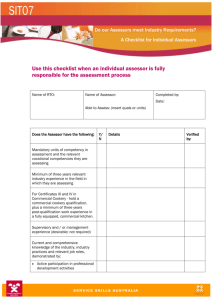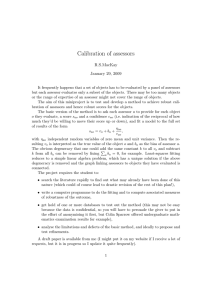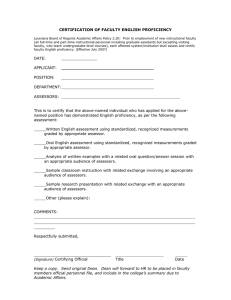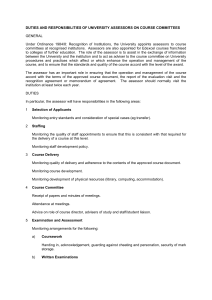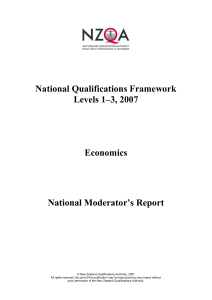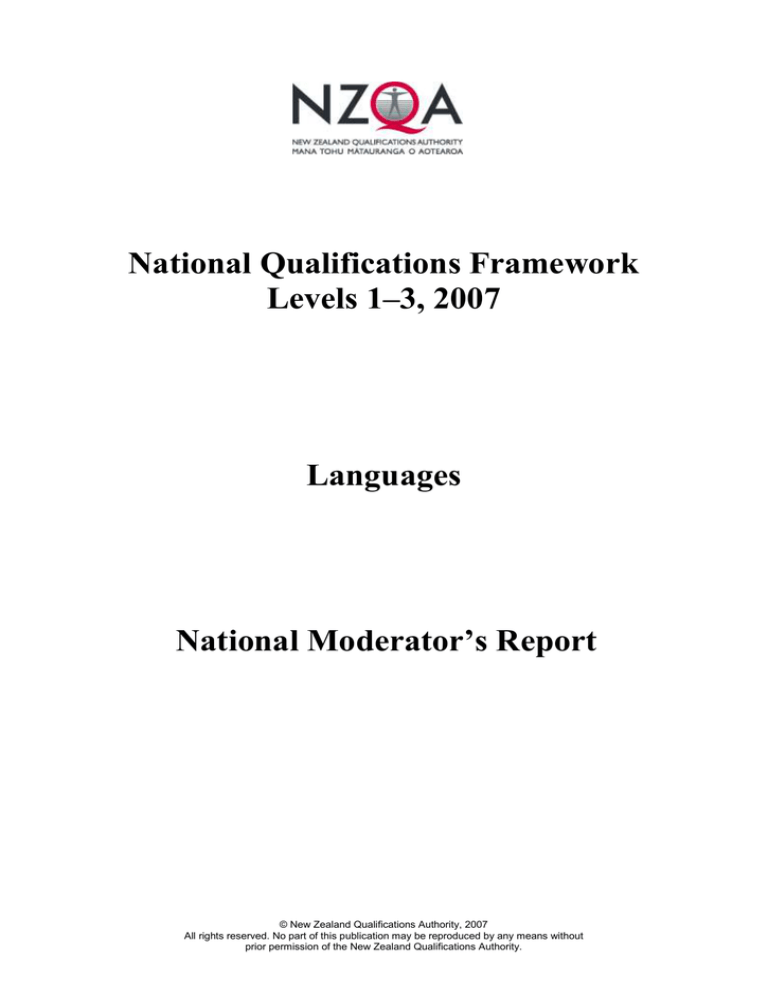
National Qualifications Framework
Levels 1–3, 2007
Languages
National Moderator’s Report
© New Zealand Qualifications Authority, 2007
All rights reserved. No part of this publication may be reproduced by any means without
prior permission of the New Zealand Qualifications Authority.
National Qualifications Framework Levels 1–3 (languages) 2007 — page 2
NATIONAL MODERATOR REPORT FOR LANGUAGES
General Guidance for Assessors of Achievement and Unit Standards
The purpose of external moderation is to provide reassurance that assessor judgments are
at the national standard and are made on the basis of assessment materials that are fair
and valid.
All assessment materials are expected to:
•
give the learner the opportunity to meet the requirements of the standard
•
have an assessment schedule that gives evidence of appropriate learner responses
and clear judgments at all levels.
The Ministry of Education contracted subject experts to write assessment resources for
achievement standards. These are not pre-moderated. The intention is that they are
modified to suit teaching programmes and learner needs. They do not provide “rules”
but suggest different ways of assessing to the nationally registered standard.
GENERAL OVERALL COMMENT
With the introduction of the new Languages curriculum in 2008, level 5 and / or level 6
can be used to provide evidence of having achieved the standard for NCEA Level 1. All
language assessors and HOD’s are advised to check all of the standards that they intend
assessing in 2008 from the NZQA website. It is important to note any changes in the
wording of the standard and the explanatory notes. From 2008 Level 1 standards will be
version 3.
While more and more assessors are creating their own tasks, many are still using or
modifying the exemplars from the TKI website. These cannot be simply downloaded
and used as they are. They need to be personalized to suit each assessor’s particular
cohort of candidates, and adapted to suit the version of the standard being assessed and
any changes in language curricula. This is especially important in French and German
where, more than in some other languages, Achievement Objectives and not simply
language structures must be used to achieve the standard, especially at level 1.
Assessors who create their own tasks should always have them pre-moderated by a
colleague in the same school or in another school.
Assessors should provide a feedback sheet to show the student how their grade has been
arrived at in accordance with the assessment schedule and also what they need to do to
achieve at a higher level in the future. The feedback sheet should be submitted for
moderation. This is especially relevant to the cumulative process of language
acquisition. One of the strengths of NCEA assessment is its transparency and the
student feedback sheet is another way of ensuring that the assessment and its judgement
is robust, clear and transparent and to all interested parties.
Concise language examples for A, M and E should be present in the assessment
schedule for all levels and should clearly show the type of language required to gain at
A, M and E. Students need to be told that they may not use these examples in their own
work unless they have been significantly manipulated.
National Qualifications Framework Levels 1–3 (languages) 2007 — page 3
At all levels, development / substantial development of relevant information is a
requirement for M and E. A definition of “ development” may be that some relevant
points are developed and “ substantial development” is when most relevant points are
developed.
Assessors are reminded that:
simple language = suggested vocabulary and structures up to and including CL 6
or equivalent.
appropriate language = suggested structures up to and including CL7 or
equivalent.
complex language = suggested structures up to and including CL8 or equivalent.
When students are required to give a variety or wide variety of language, this language
may come from any level, not just the level being assessed. However a vocabulary item,
from a particular level, on its own is not considered to be evidence that a curriculum
level has been met. Nevertheless the variety or wide variety of language is what the
student uses to develop relevant information or give a point of view.
In 2007 more schools used Unit Standards. Some materials were not developed with
clear instructions, assessment schedule and examples of learner responses. Assessors
need to ensure that they provide a task using the appropriate curriculum levels for the
requirements of the task. There also needs to be a clear outline of how the work will be
assessed and what constitutes judgement for gaining credit. The procedures for unit
standard assessment should be similar to the achievement standards.
AS 90073, 90079, 90085, 90091, 90097, 90103, 90109, 90120, 90126 “Give a prepared
talk in (selected language) on a familiar topic”.
In 2007 this standard was version 2. From 2008, it will be version 3.
In French and German especially, assessors may be downloading tasks from the TKI
website with no reference to the changes that have taken place in the curriculum since
2005. For example, past tense in these languages is now curriculum level 5. Assessors of
all languages need to ensure that the task created for 1.2 allows the learner to show that
they can provide evidence of simple language up to and including Curriculum Level 6.
Students should do this through the communication of Achievement Objectives and not
by just relying on certain language structures and vocabulary items.
To achieve the standard at Level 1 the student needs to show evidence of simple
language up to and including level 6 (or equivalent), but that does not mean that all the
language used needs to be at that level. It is disappointing that in many languages, level 5
is being ignored. For all levels the productive oral and written standards should be a
chance for the student to show case all of the language that they have learnt up to and
including this level and even beyond if the student has the capability.
When assessing this standard, assessors should note that learners may have more than 10
words on a cue card (although up to 10 words is still acceptable). The learner must not
read their speech from the card/s. If during the moderation process the student “sounds”
as though they are reading then the assessor can expect the Moderator to comment
accordingly. Of course if the assessment is videoed then there is no doubt as to the
authenticity of the judgement. For this reason and because a number of schools are
reporting that students perform better when only having a set number of words on a cue
National Qualifications Framework Levels 1–3 (languages) 2007 — page 4
card (they have to prepare more thoroughly), assessors may like to consider restricting
the number of words that may be used. Nevertheless the number of words that can be
used is a matter of negotiation between the assessor and the student(s).
A prepared talk must to be an audience of one or more and students may not record their
own. If the recording is interrupted for any reason, an explanation by the assessor should
be given.
All language standards are for second language learners and students are not expected to
have native speaker pronunciation or accent. Assessors should take this into account
when making judgements. Excellence should only be awarded when “any errors do not
hinder communication”, hindrances caused by mispronounced words and / or poor
intonation can be considered.
Student performances should either be recorded digitally or videoed. It is the school’s
responsibility to ensure that:
the recording is audible
the speaking order of the students selected for moderation is clearly indicated
the recording is in a readily accessible format.
It is particularly disturbing to hear on some speeches or conversations excessive
background noise as though the assessment is taking place during school interval or
lunch breaks. Assessors are reminded that internal assessments carry the same weight
and importance as external assessments and should be carried out under the same
conditions as external examinations.
The prepared talks/ presentations/ speeches have as an expectation that the student will
have spent an appropriate amount of time in class and at home preparing and learning
their performance. It is not appropriate for the assessor to prompt during the assessment.
It is also important that the student knows that the time requirement for the assessment
but in all cases QUALITY is always more important than QUANTITY.
AS 90074, 90080, 90086, 90092, 90098, 90104, 90110, 90121, 90127 “Converse in
(selected language) in a familiar context”.
The conversation standards are still proving to be the most challenging to assess. The
National Moderator’s report for 2006 indicated that the assessment at level 2 and 3
needed to be a “natural conversation” not an assessor-led interview. “Natural
interaction” is expected, whereby an exchange of information that is not totally prelearned and has some spontaneity is presented as evidence.
For all 3 levels cue cards may not be used. For version 3 of level 1, the time requirement
is about one minute.
It is important that the task is of a type which allows the student to develop /
substantially develop relevant information and to use a variety / wide variety of simple
language in the answers to achieve at M and E. To gain an Achieved there must be
evidence of language up to and including Curriculum Level 6 or its equivalent. Thus it is
recommended that tasks be open ended rather than transactional to allow the student to
do this.
National Qualifications Framework Levels 1–3 (languages) 2007 — page 5
At all 3 levels, the placement of the examples of student response must be on the
assessment schedule and written in the target language. The conditions of authenticity
mentioned in 1.2 also applies for 1.3.
From 2008 version 3 should be used for Level 1.
AS 90077, 90089, 90101, 90107, 90113, 90130 “Write text in (selected language) on a
familiar topic, with the support of resources”.
The purpose of this standard is to allow students the chance to draft, craft and produce a
piece of written work over a period of time. It is not the same sort of assessment as 1.5
which is done in the external examination at the end of the year.
The task needs to allow drafting and crafting to take place. An email (unless it is an
official one) postcard or letter to a friend are not suitable. It is more appropriate that the
student be asked to produce a brochure, hand book, guide book or short story. While
only the final piece of writing is assessed, the student needs to show evidence of
drafting and crafting in their work. This evidence is also to be sent along with the final
piece for moderation purposes. Assessors are asked to send the original copies of all
student work rather than photocopies.
Regardless of how long the student may be given to complete this task it is very
important that the assessor maintains the following conditions:
the task is given at the beginning of the first session
all resources are provided by the assessor
previous marked work is not appropriate as a resource
if text books (or other printed material ) are used the student may not copy
directly from them. They must significantly manipulate the text/s to show that it
is their own work
if a computer is used during the assessment process the disc is handed in and
stored by the assessor at the end of each session
all students should have access to the same resources
students may bring nothing in and take nothing out of the assessment room
all student produced work stays in the assessment room
the authenticity criteria mentioned in the oral standards also applies to the
writing.
Feedback, if considered appropriate, may be given by the assessor at any time before the
final piece of work is produced. It may be written or oral, individual or group. Evidence
of written feedback may be seen in the drafting and crafting pieces which have to be
included for moderation. If an assessor decides that further teaching is necessary before
the assessment continues, this is perfectly acceptable as long as the integrity and security
of the standard is maintained.
Marking or correcting the drafted piece(s) of work handed in is not appropriate feedback.
Feedback must be general only and the underlining or indication of specific errors or
problems in language use may not occur.
From 2008 version 3 should be used for Level 1.
National Qualifications Framework Levels 1–3 (languages) 2007 — page 6
AS 90383, 90389, 90396, 90402, 90408, 90485, 90414, 90420, 90427 “Give a prepared
spoken presentation in (selected language) on a less familiar topic”.
Less familiar refers to situations that are outside the everyday experiences of the student.
For Level 2 “appropriate language (up to and including CL 7 or equivalent) should be
used.
Students may have more than 20 words on a cue card. The number of words may be
negotiated between the assessor and the student but the student may not simply read
from the cards.
The speech at level 2 (and 3) needs to be organised for M and E. The student must be
told this in both the conditions and the assessment schedule.
While there is a time requirement of at least two minutes, in all cases the quality of the
speech is more important than quantity. For excellence there is absolutely no need for the
speech to be excessively long.
In 2008 version 2 of the standard should be used.
AS 90384, 90390, 90403, 90409, 90415, 90421, 90428, 90486 “Converse in (selected
language) in a less familiar context”.
All level 2 (and level 3) tasks should be written so that the student not only has the
responsibility but also the chance to lead and control the conversation. Thus there is no
need for a set group of questions which the assessor must ask regardless of the path the
conversation is taking. Nor is it appropriate for the student to just ask one question or be
asked at the end of the assessment whether they have any questions.
One of the keys to ensuring a successful outcome with this standard is, apart from more
practice conversing in the classroom, how the task is set up. It is recommended that it be
“open ended “rather than transactional and between two casual / informal acquaintances
with the student playing the leading role. With this in mind it is important for assessors
at level 2 to understand that even though explanatory note 7 states that “an interview or
role play” are possible conversation type tasks, they do not work well as a general
conversation because they tend to be learnt by heart and so are no longer in the spirit of
the assessment. Assessors are recommended to consult the level 3 conversation standard,
explanatory note 6 for better suggestions.
One way in which assessors can avoid the question / answer situation at level 2 and 3 is
to consider the idea of creating a portfolio of student conversations. When the level 1
standard was reviewed the explanatory note that the conversation must not be between
two students was removed and this change will occur at level 2 and 3 as the review
process continues. Assessors are reminded that the standard requires evidence of
conversation.
In 2007 one assessor presented for moderation a portfolio of student conversational
performances. The students sounded as though they were enjoying the experience and
certainly the atmosphere created was much more natural and far less nervous than the “
interrogation” that has been very much part of this standard in the past. Certainly
assessors should feel encouraged to experiment with this style of assessment but from
National Qualifications Framework Levels 1–3 (languages) 2007 — page 7
the Moderator’s point of view it is very important that when these portfolios are sent for
moderation, the assessor ensures:
in the overall portfolio presentation there be clear evidence of the requirements of
the assessment schedule for A, M and E.
there be evidence of relevant information for the task/s being discussed
students convey and seek relevant information (level 2)
the exchange and supporting of ideas and / or opinions be present (level 3)
there be evidence of the time requirement for each student
each student shows development (some / substantial ) of relevant information and
that appropriate ( level 2 up to and including Curriculum Level 7 or equivalent)
and complex ( level 3 up to and including Curriculum Level 8 or equivalent)
language (variety / wide variety) is used
students being assessed are clearly identified. (An ideal way of doing this would
be for the students to be videoed.)
It is suggested that assessors refer to the Japanese assessment activity on TKI.
As with all evidence for the assessment of languages, QUALITY is always more
important than QUANTITY. There is no need for conversations to be excessively long
(15 minutes and more!). Student contribution to the conversation is about 2 minutes. Cue
cards may not be used.
Students do not need to show the same type of development as they do in a prepared
speech. Development and variety may involve interaction, referring back to what has
already been said, clarifying the intent or using formulaic expressions. Communication
will be achieved when the meaning / direction of the conversation has been successful
and where both parties have understood what each other wanted to communicate.
Pronunciation, pausing and intonation will help to achieve effective communication.
In 2008 Version 2 of the standard is to be used.
AS 90387, 90400, 90406, 90412, 90418, 90431, 90489 “Produce crafted writing
(selected language) on a less familiar topic, with the support of resources”.
National Qualifications Framework Levels 1–3 (languages) 2007 — page 8
Refer to comments for level 1 crafted writing assessment.
In 2008 version 2 of the standard should be used.
AS 90547, 90553, 90559, 90565, 90571, 90577, 90583, 90589, 90672 “Give a prepared
speech in (selected language) using complex language”.
Students must express a point of view. However the point of view does not need to be
developed for merit and excellence. It needs to be clearly expressed and not just inferred.
Candidates should be encouraged to use phrases that help to clearly express the point of
view.
The time requirement for this standard is at least 2 minutes but as usual quality is more
important than quantity.
Cue cards may be used but they may not be read from.
The prepared speech must be organised for both merit and excellence. Additionally, the
excellence criterion states” Give a clear, organised and fluent speech”. Fluent means that
the flow of the speech is easily followed and understood and has not been marred by
long pauses which have interrupted the flow. It does not mean a native speaker level of
speaking or rapid delivery.
AS 90548, 90560, 90566, 90572, 90578, 90584, 90590, 90673 “Converse in (selected
language) using complex language in less familiar contexts”.
Refer to comments for level 2 conversation assessment.
Cue cards may not be used.
The contribution by the student to the conversation should be about 2 minutes but quality
is more important than quantity.
The conversational task should be linked directly to the achievement objectives relevant
to the curriculum of the language and the level being assessed so that the student is able
to use language at a complex level.
Complex language should be used in less familiar contexts to exchange and support
relevant information, ideas and or / or opinions.
Fluency refers to the flow of the student contribution where the meaning and the
communication is not marred by long pauses, and / or language errors . It does not refer
to native speaker ability or delivery.
In 2008 version 2 of the standard should be used.
National Qualifications Framework Levels 1–3 (languages) 2007 — page 9
AS 90551, 90563, 90569, 90575, 90581, 90593, 90749 “Write crafted text in (selected
language), using complex language, with the support of resources”.
See notes level 1 crafted writing assessment.
For level 3, the crafted text needs to have organised relevant information / ideas and / or
points of view expressed by the use of complex language.
While there is a word or kana count as in all other productive assessments quality is
more important than quantity.

